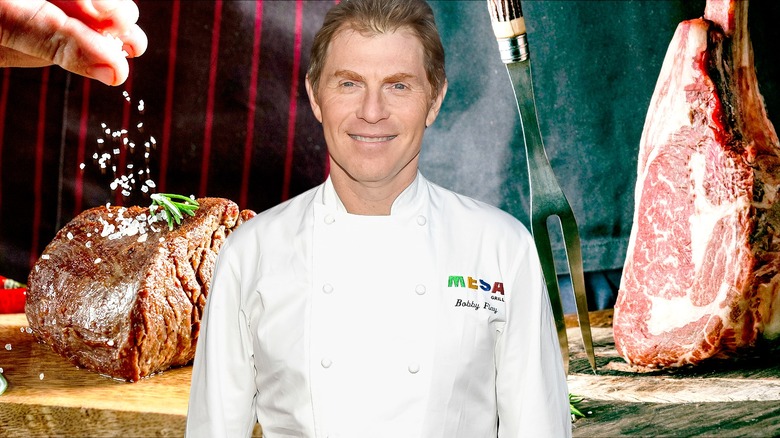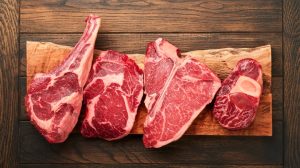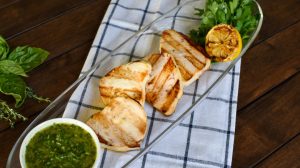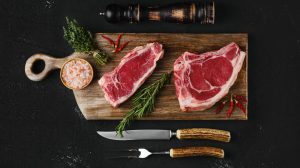Static Media / Shutterstock / Getty
Bobby Flay has come a long way from his days of learning to cook with an Easy-Bake Oven when he was about eight or nine years old. Since then he has starred in a plethora of TV shows, including the wildly popular “Beat Bobby Flay” and “Boy Meets Grill.” He’s also won more Iron Chef competitions than should be legal, and has earned several coveted James Beard awards over the years, including for the Who’s Who of Food and Beverage. All this is to show that Bobby Flay knows his stuff when it comes to food and cooking, but Flay’s especially adept at making steaks, which is why it’s a good idea to look to him before cooking up one of your own.
Flay’s steak expertise is evident in several ways. For one, he had a restaurant in Atlantic City for several years that was literally called Bobby Flay Steak, which should be telling enough. But if you didn’t get a chance to try any of the steaks on the menu there, you won’t have a hard time finding a Bobby Flay steak recipe online. So let’s take a look at what Bobby Flay does to make his steaks as perfect as possible, and see whether we can’t follow in his footsteps in our own kitchens.
1. Switch up the mushrooms in a Salisbury steak
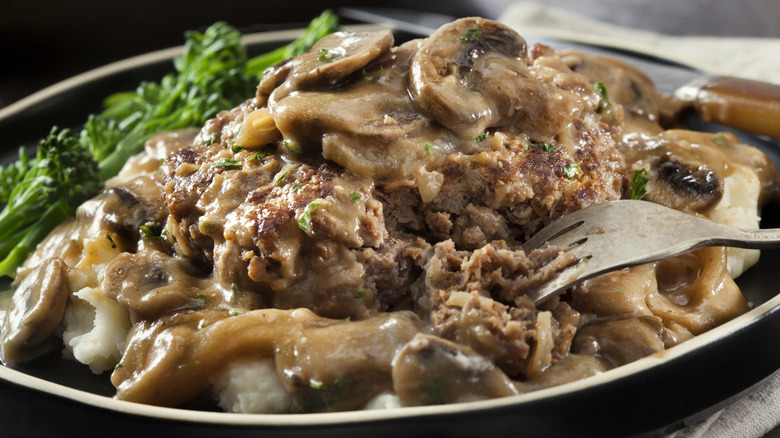
The trick to making the ideal Salisbury steak is not so much in the meat itself, since it’s largely made with ground beef, but in the topping, which is famously made from mushrooms. But mushrooms can be hit or miss, and if you’re using a mediocre ingredient in your meal, especially when it plays such a crucial role in the overall dish, the entire meal is likely to turn out to be just as mediocre.
Bobby Flay’s suggestion to upgrade Salisbury steak, then, is simple: just swap out the typical button mushrooms — which, let’s face it, can be a bit drab — for something that is much more exciting for your palate. The point here is to use your favorite type of mushrooms, but please allow us to give some recommendations in this department, as some mushrooms are way, way better than others. Flay, for one, advises using cremini mushrooms, which are the stars of his own recipe, and indeed they might just be the best type of mushrooms to pair with any steak recipe. But Flay also says that shiitake and portobello mushrooms can work just as well, and it’s worth becoming acquainted with the wide range of mushroom varieties that are out there so you can open up the door to a whole new world of mushroom flavors.
2. Don’t skimp on the seasoning

Steak is not something you go for when you’re looking for a subtle, delicate flavor, most of the time. A steak comes with big flavor and big commitment. This is probably why one of Bobby Flay’s top tips for cooking steak is to not skimp on the seasoning. The salt will do more than just flavor your meat — it will also help break down the fibers in the cut and make sure it becomes tender instead of chewy.
Once this is done, it’s time to turn your attention to the rest of your seasoning. A strong, solid rub can only do good things for your steak meal, and in particular, we recommend adding plenty of freshly ground pepper to any spice mixture you concoct. Or in a pinch, you can even use it on its own to great effect. No matter what, this ingredient in your dry rub is sure to help your steak develop a heavenly crust. Just don’t forget to rub the pepper into the steak — otherwise, it risks not sticking to the steak and burning up in the pan instead.
3. Add tomato paste and cream to a Salisbury steak
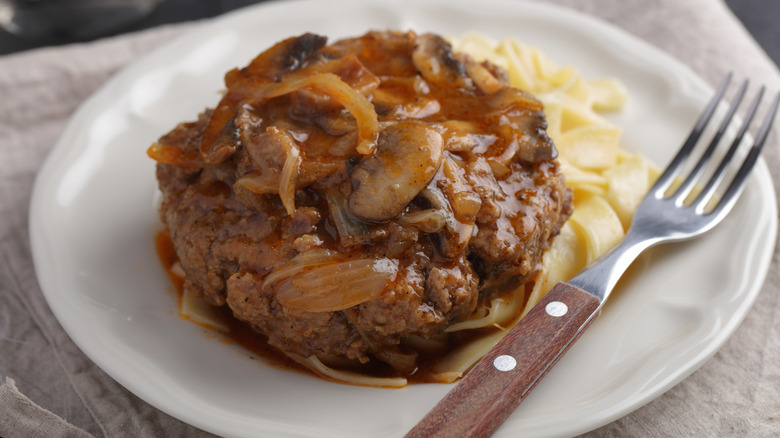
StockphotoVideo/Shutterstock
While the mushrooms might be what make or break a Salisbury steak, the rest of the ingredients are not to be neglected. Bobby Flay likes to amp up his Salisbury steak by making a creamy and thick sauce.
To prepare it, he takes some tomato paste and half-and-half and adds them to the more traditional ingredients, which typically include the likes of Worcestershire sauce, Dijon mustard, chicken or beef broth, ketchup, and garlic (but omits the flour, which is sometimes used to thicken the sauce). In this case, with the cream, it is no longer necessary. Once the steak is ready, saute the mushrooms and onions before adding the usual Salisbury steak sauce ingredients followed by a few tablespoons of tomato paste. Cook the sauce for a few minutes on low heat, and just before you’re ready to call it a day, add a few splashes of cream.
4. Broil a porterhouse steak with butter
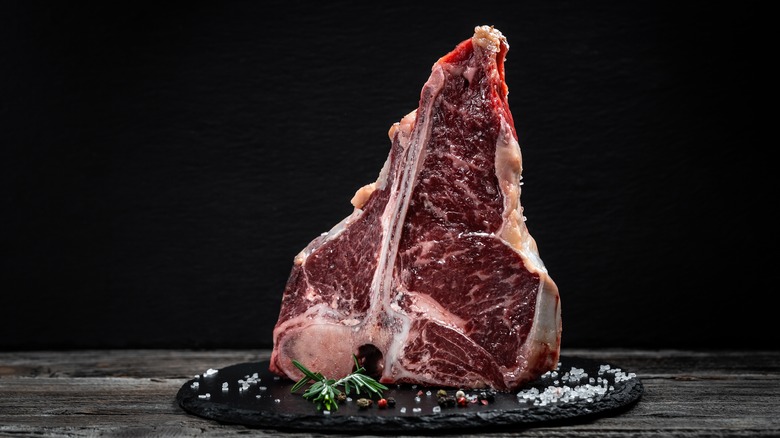
sweet marshmallow/Shutterstock
Steaks typically contain a fair amount of fat, so you might think that it’s not necessary to add more during the cooking stage. But that might be because you haven’t had a steak with a generous dollop of butter in a while. Butter is that magical ingredient that makes everything taste better, but it can do absolute wonders for steaks in particular. Bobby Flay, in fact, has an important butter tip when cooking porterhouse steak.
According to his method, it’s important to start your porterhouse steak preparation by searing the steak in a skillet for a few minutes before cutting off the bone. Flay then arranges the meat back around the bone, places a few dollops of unsalted butter on top, and broils the meat until crusty and buttery on the outside, and beautifully pink on the inside. The butter will help tenderize the beef as it melts down with its juices, creating a rich, creamy, and extraordinarily flavorful result.
5. Cook your steaks less
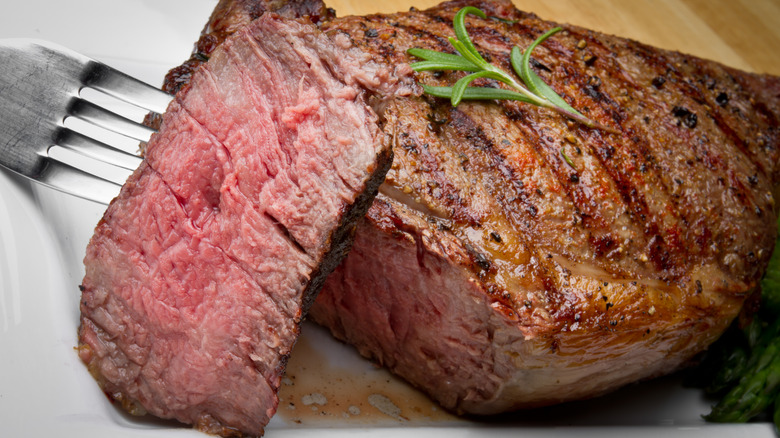
Grandriver/Getty Images
One of the most common mistakes home chefs make is overcooking their meat. It’s easy to understand why. No one wants to deal with the consequences of undercooked chicken or a steak that’s cold and flavorless in the center. But if you must err in cooking steak, it’s best to err on the side of raw. If you pull out your meat and find that it’s not cooked enough for your liking, you can always put it back in the pan for a few more minutes. The opposite is not possible without a time machine. Not to mention the fact that an undercooked steak, as long as the meat is good, is unlikely to cause any intestinal problems or lead to food poisoning.
So to save us all from this major home chef faux pas, Bobby Flay has given us the secret to a perfect steak that is not too cooked or too raw. And that secret couldn’t be simpler: just stop cooking your steak right before it reaches your desired internal temperature. For example, if you’re going for a medium-rare steak, which should have an internal temperature of about 130 F, take your steak off the heat when it reaches about 125 F. That’s because the steak will continue to cook slightly even after it’s taken out of the oven or off the pan, leading the internal temperature to actually rise beyond what you had intended.
6. Grill steaks with the lid on
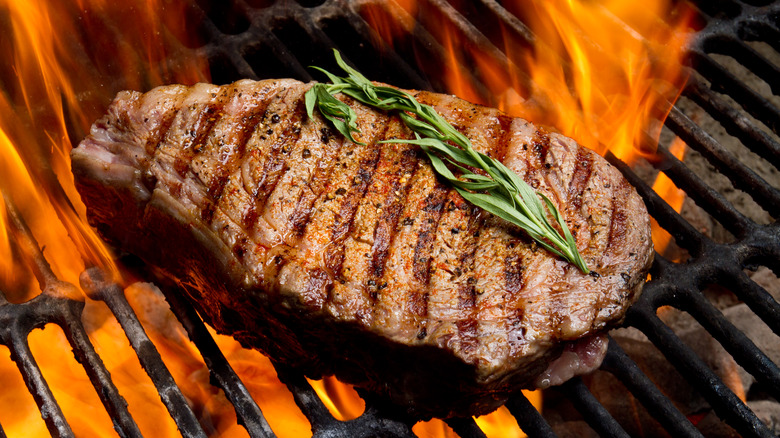
Grandriver/Getty Images
Grilling is a popular American pastime, so if you’re going to be doing it a lot with friends and family, you may as well enjoy the food part as well. To that end, Bobby Flay has a grilling rule you should never break, which is that you should always grill your steak with the lid on. This piece of advice comes from his general rule of thumb, where items that cook quickly should be grilled with the lid off, while those that take a little more time should have the lid on. This keeps the food from drying out before it gets cooked through. He also cautions grill chefs from peeking under the lid throughout the process, which seems like a small thing, but it can have a big impact on the end result.
Try out this rule for yourself with our herby grilled flat iron steak recipe. Prepare your steaks, and then grill on medium-high for about five minutes, with the lid on of course, before flipping. Meanwhile, combine garlic, capers, lemon juice, and olive oil, and pour this mixture over the steaks once they’re off the heat.
7. Ensure the meat is fresh
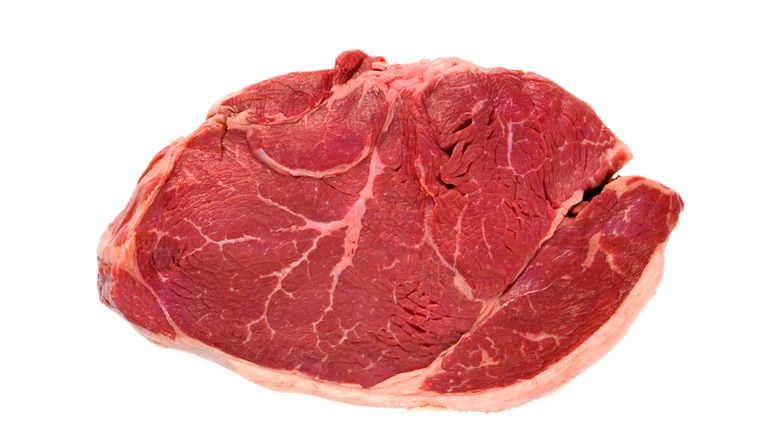
Nycshooter/Getty Images
When you set out to prepare a meal, the result will be much tastier if all the ingredients are fresh, but this is especially true of meat. An old slab of meat could be going the way of all flesh without you even knowing it before you bite into it. This could be downright dangerous, especially if you’re planning on cooking your steak rare or medium-rare. But more than that, a non-fresh piece of meat just isn’t going to perform as well in terms of texture and flavor. Moreover, the shrink wrap found on many prepackaged, store-bought meat — which is typically not as fresh as what you can get straight from the butcher — can trap moisture inside the packaging, which causes more juice to be lost, and therefore more flavor. So listen to this cooking tip, one of Bobby Flay’s best, before you go shopping.
So now that you know about the importance of buying fresh meat, it’s time to head to the butcher. But don’t be intimidated. We’ve put together a guide that will help you figure out which questions to ask your butcher to ensure you get the best possible cut of meat, including where the meat comes from and what the animal ate. With these questions to get you started, shopping at the butcher’s should be a breeze.
8. Look for lots of marbling
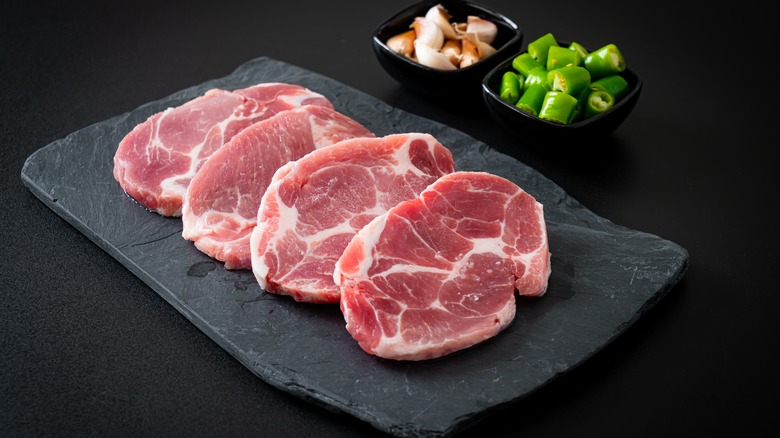
gowithstock/Shutterstock
We all know about the joys of having a beautiful, long lasting marble countertop, but did you know that good marbling is also a desirable feature in steaks? Bobby Flay knows it well, which is why he recommends looking for a lot of marbling when you head out to buy your steaks. As he explains in a recent Food Network Facebook post, “That means it’s going to have enough fat, which will ensure lots of flavor, and of course juiciness when the fat melts.”
And while we’re at it, you should know that marbling is also important when selecting meat for your burgers. A good amount of juiciness is exactly what you need in a good burger, and that juiciness comes when the fat in the beef, which is the marbling, is plentiful. A combination of ground chuck and short rib should do the trick in that department, as would brisket and hanger steak. Just remember that whether you’re dealing with steaks or burgers, you’ll want to avoid lean meat at all costs, as that is your surest bet of achieving a dry dish.
9. Make a spice rub with pantry items
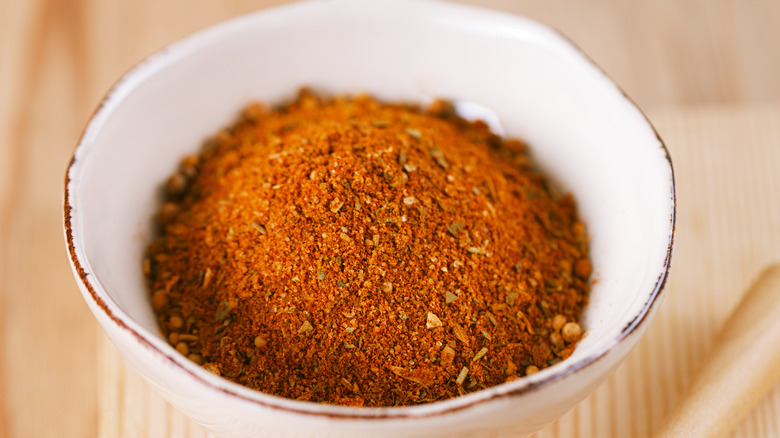
Lvenks/Getty Images
A good chunk of steak with just salt and pepper and its own divine juices is all one can really ask for, but sometimes it might be fun to change things up a bit with some different spices and flavorings. But according to Bobby Flay, you don’t have to go out and buy any special ingredients to achieve this. All you have to do is root around in your pantry and pull out some of those spices you forgot you even had.
In a recent YouTube video, Flay showed us exactly how to do this. He went into his pantry and found some paprika, cumin, chili powder, ground coriander, fennel, and a Mediterranean spice containing the likes of oregano, thyme, and dried parsley. He then mixed these together to create a spice rub and rubbed it right into his raw steak evenly, covering it completely. Just make sure you only put the rub on one side instead of both, because as Flay says, “I wanna taste the meat.” While the rub will provide an extra boost of flavor and a nice crusty texture, it shouldn’t let you forget that the meat is still the star of the show.
10. Use a cast iron pan
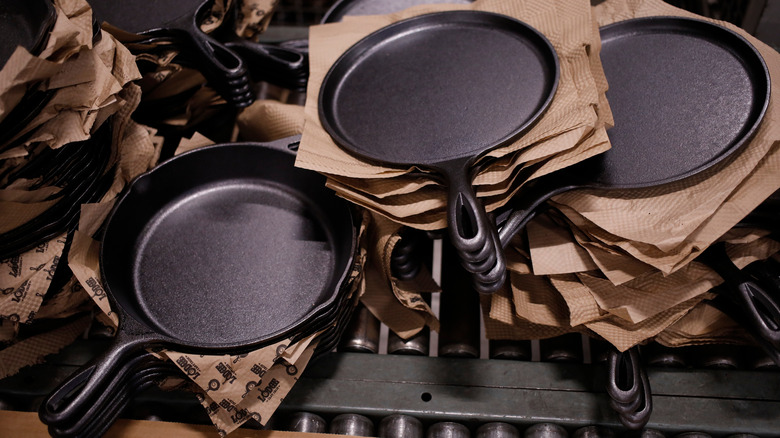
Bloomberg/Getty Images
Ensuring the quality of the ingredients is not the only important step to take when getting ready to cook steak. You also have to use the right tools. In a recent YouTube post, Bobby Flay insists that “if you have a cast iron pan, that’s the best possible pan to use — something that’s nice and heavy.”
Look agrees, because we’ve recommended searing steak as one of the absolute best uses for a cast iron skillet. And this is no accident. A heavy pan like this gets hot quickly and stays that way, ensuring a more even and consistent distribution of heat. This will allow you to better control the cooking process. This also means that you won’t have to stand there and cook your steak for ages. A few minutes on each side should do the trick, depending on your desired level of doneness.
11. Cut flank steak against the grain
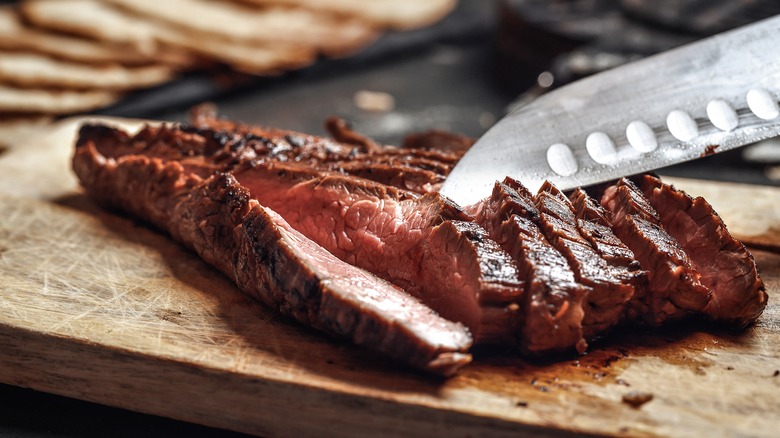
Jevgenija ZUK/Shutterstock
Once you’ve prepared your perfect steak, according to Bobby Flay’s instructions or otherwise, it’s time to serve it up, and for this, too, our chef has some pearls of wisdom. The one we think is most important is his instruction on how to cut flank steak. In a recent YouTube post, Flay explained that to ensure maximum flavor, it’s important to cut flank steak thinly and against the grain, which is to say the muscle fibers.
And we happen to agree, as this type of cut helps the meat come out tender rather than chewy. Flank steak comes with thicker muscle fibers than many other cuts, as it’s practically the cow’s abs. And while cows don’t exactly do a lot of ab workouts, they still use these muscles to stand around and move their hooves, which they do quite a lot. So to make sure you’re cutting against and not with the grain, place your cooked meat on a cutting board and take a long, hard look at the muscle pattern. Then just cut in the opposite direction.
12. Don’t grill cold steaks
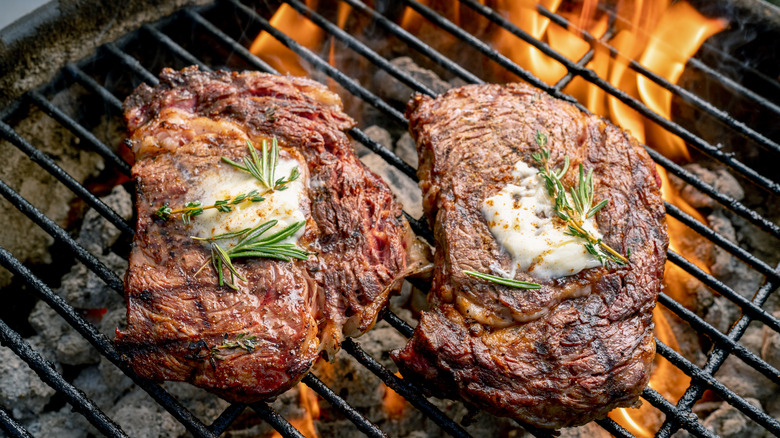
Grandriver/Getty Images
Unless you’re ready to start cooking up a feast as soon as you get home from the grocery store, you’re probably going to store your new steaks in the fridge for a few hours or overnight. While that’s a good idea in order to ensure the freshness and preservation of the meat, according to Bobby Flay it’s also a good idea to take that steak out of the fridge at least 20 minutes before you’re ready to plop it on the grill. The key here is to give the steak time to get to room temperature, as a cold steak risks cooking unevenly and becoming tough to chew.
See for yourself by trying our grilled hanger steak recipe both ways and see which one comes out better. Or save time, money, and the environment and just take our word for it and cook up a room-temperature steak. To make the marinade for this one, combine soy sauce, olive oil, lemon juice, Worcestershire sauce, garlic powder, and black pepper and pour it all over the steak, which then needs to be stored in the fridge for about 2 two hours. This is where you plan ahead and take the steaks out of the fridge 20 minutes before it’s time to grill them. Cook them at 250 F until the desired doneness and top with a sauce made with capers, parsley, oregano, garlic, lemon juice, olive oil, red chili flakes, and black pepper.
13. Leave it be
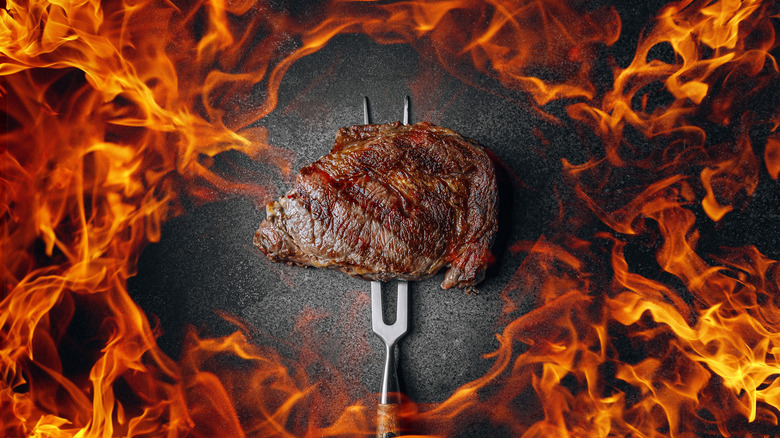
Mikhaylovskiy/Shutterstock
Another of Bobby Flay’s top tips for cooking the perfect steak is the simplest thing that can be. In fact, it makes life a whole lot easier, because he says to avoid moving or flipping the steaks too often as you grill them. Suddenly, the act of grilling a steak has become a whole lot easier. Not only can you now sit back and relax and not be constantly standing by the grill, but you also won’t have to deal with your meat sticking to surfaces or falling apart, which is what can happen when you play around with it. That’s because as the meat sits on a very hot surface, it starts to form a crust, which will naturally help the meat become unstuck when it’s actually time to pull it off.
Try your hand at this new technique by following our recipe for grilled skirt steak with chimichurri. With this one you’ll be forced to leave the steak well enough alone, as you’ll need to turn your attention to preparing the chimichurri while the steak is cooking.
14. Cook on very hot surfaces
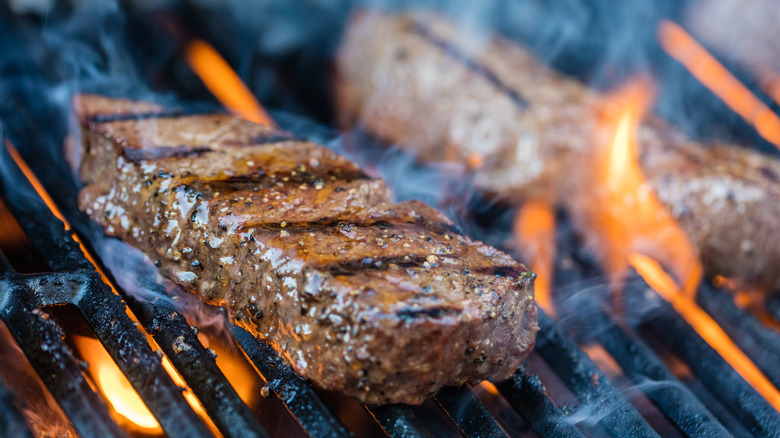
Instants/Getty Images
The formation of a crust on a steak is important to ensure flavor, texture, and easy handling in the pan. But how to achieve this elusive effect? It’s actually not that elusive, because all you have to do is make sure your pan is really, really hot before the steak even goes near it, according to Bobby Flay. To avoid putting a steak in too soon, just run your fingers under the sink for a second and flick a small amount of moisture onto the pan. If the pan doesn’t sizzle immediately, then wait a few more minutes and try again. If it does, then you’re good to go.
To help you out in your endeavor, Flay also suggests pouring a light oil in your pan before adding the steak. Canola, vegetable, or peanut oils are all good choices because of their higher smoking points than olive oil.



